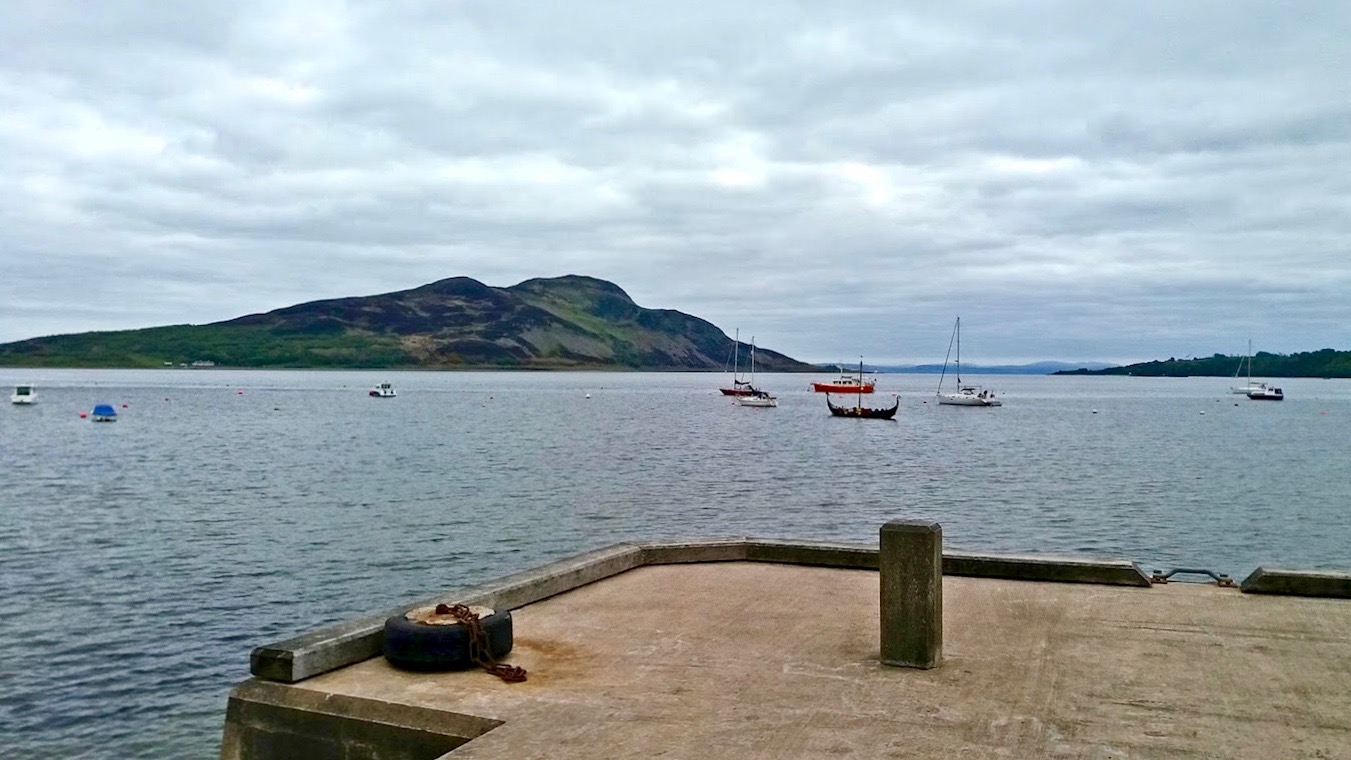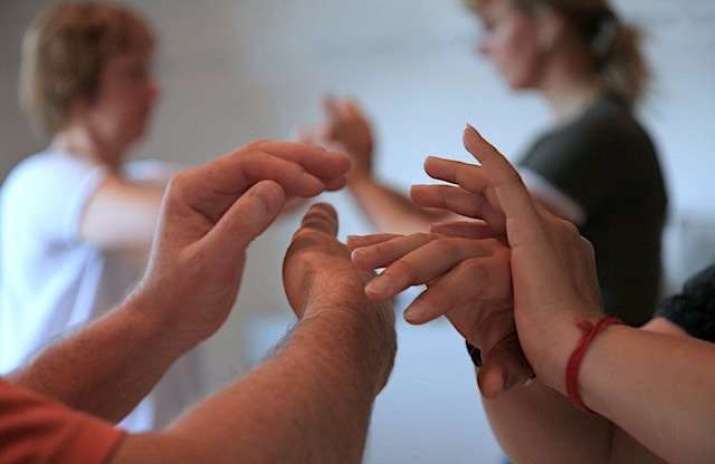
The weather forecast for our three-day retreat on Holy Isle (near the Isle of Arran, off the Scottish mainland, which is also essentially an island) seemed fine: sunny spells and moderate wind speeds. So the size of the swell at the Lamlash Pier comes as a bit of a surprise.
The Holy Isle ferry is still anchored out at sea, looking rather slight bobbing perilously on the whitecaps. Grant, the kindly Buddhist ferryman, explains that it is not so much the strength, but the northeasterly direction of the wind that is the problem: we may not make it across today. He will make a decision in two hours, when the wind and waves may have calmed . . . he doesn’t sound too hopeful though. There are 17 of us, keen to “come to our senses through yoga and meditation”—the title of the retreat—with another 10 on their way on the second mainland ferry. Most of the group goes to the corner café for tea and scones and to escape the chilly breeze, while I sit down in the rickety ticket cabin with Grant to have a chat and discuss our options.
I have been running retreats here for many years and feel myself gently slotting back into island time; that sense of surrendering control and respecting the greater forces of the natural elements. There are pauses in the conversation while we watch the gulls and the clouds flowing fast over the Holy Isle hills, just a 15-minute boat ride away. I am used to some people arriving late or leaving early, but this is the first time that the whole group may not be able to make it over to the retreat center until a day later. Grant has some ideas: there is the Arran Lodge nearby and we make phone calls. It looks like we can all find accommodation there in single and double rooms, at a group discount, and will be able to use a function room for an evening session. Grant takes me over in his car so I can have a look. I am warmed by everyone’s helpfulness.
Zipped up in windproof jackets and woolen hats, the group reassembles with their bags and yoga mats, some looking cautiously hopeful, others a little apprehensive. Perhaps half of them have been on retreat with me before. I wave them closer, momentarily feeling rather more like a tour guide than a retreat leader, and explain the situation. In the back of my mind is a sense of the potential of this moment; to see it as an opportunity rather than an annoying obstruction, and which way it goes to some extent depends on the stance I take.
Part of my awareness has descended through my back and my legs into the ground, drawing on the support of the huge, steady body of the earth. I do my best to speak calmly and slowly, making myself heard above the racket of the breakers against the pier. People look alert and present, paying full attention to the details of what I say. The luggage will be driven to the lodge in cars and we’ll walk along the shore. Everyone has to take care of their own dinner as the lodge is self-catering. The village shop is open until late. In all likelihood we will be able to get across to the retreat center early tomorrow morning, in four ferry runs, and there will be porridge waiting for us.
“The retreat starts now,” I emphasize with an encouraging smile. “Enjoy every moment!” People are nodding and there is a noticeable absence of complaints or fretting, but a readiness to adjust to changing circumstances.
But as a species we are very good at worrying and it takes conscious effort and training to spot and resist the compulsion to assume the worst. After the evening session at the lodge several people approach me: “Will there be a gluten-free breakfast option when we arrive?” “Are there spare blankets in our rooms?” The questions themselves are fair enough, simply an expression of basic, universal needs for safety and comfort; although . . . how should I know about blankets having just arrived myself? I pick up the underlying anxiety; nervous systems spilling over with adrenalin. I catch myself repeatedly wondering about a couple of people who have yet to arrive; there is no reply to my messages. This famous quote by the 10th century Tibetan Buddhist monk Atisha comes to mind: “If you can do something about a situation, why worry? And if you can’t do something about a situation, why worry?” (It turns out later, that I had made a mistake and listed them on the wrong registration sheet—they were not due to attend this retreat at all!)
Does mindfulness practice help one feel less stressed in unforeseen circumstances such as these? One would hope so, but I think it depends on how you practice. When you focus on the object of meditation, for example the breath, in a slightly willful way—an attitude that is common in our task- and results-driven world—you will probably experience inner thoughts, difficult emotions, unpleasant body sensations, or outer sounds as unwelcome intrusions, as obstacles to try to overcome. Meditating can then feel like a bit of a struggle. You have the best of intentions, yet however hard you try, you never quite get back to that lovely peaceful state of mind that once bowled you over. Does this sound familiar?
Another style of practice is more open and relaxed, allowing everything that arises to be part of the meditation, pushing nothing away. Someone noisily blows their nose? Thank you for the wake-up call. You can’t stop thinking about your work? It shows how much it matters to you and maybe the energy of the needs behind the thoughts can be creatively integrated into the meditation. In my experience, this is a more successful way of preparing for life’s ups and downs; more flexible, kind, and encompassing, and with less of a self to bolster up with some success story. It is surprisingly elusive, however. In the name of relaxation it is only too easy to fall into the opposite extreme to willfulness and go a bit dreamy, flat, and unengaged, or even to fall asleep.

Halfway through our Holy Isle retreat, I introduce the participants to an exercise called “Following Hands.” It is a variation on a Tai-chi partner exercise and involves one person lightly placing a hand on the back of the hand of another person and being led by them through space. The idea is to gain some somatic insight into the art of following the breath in sitting practice. You go wherever your partner takes you: up and down, in circles, at different speeds, sometimes pausing. You feel your body stretching up, bending down, twisting and turning, all in response to the guidance of your partner’s hand; first with eyes open and then closed.
After a while I instruct the followers to try a little harder; to exert some control in order to not lose the contact under any circumstances. The character of the movement now changes—people clasp their supposed leaders’ hands and it looks more like a jerky fight than a dance. There is also a fair bit of laughter. Then I encourage people to go to the other extreme: “couldn’t care less.” The hands disengage? Never mind. It’s ok to “be away with the fairies,” planning your next meal or holiday. The tone of the movement now is a little listless, sluggish, and uninspired. After a while I encourage the group to find a balanced kind of engagement, neither trying too hard nor too little. “How do you know you got it right?” I ask.
When we debrief after the exercise, people talk about a dance-like quality, a sense of pleasure and flow, of ease and pliability, of losing oneself in the activity. When we sit down to meditate on the breath we go through the same stages of trying too hard and too little before settling into an enjoyable, sustainable state of balance that is constantly renewing itself. Being on the ball is an apt idiom for mindfulness, suggesting the image of someone continuously adjusting their balance to remain atop a revolving body.
I’ve recently added a further, rather fun stage to this exercise: this time you only touch with the tip of the index finger and when it’s your turn to follow, you do your best to maintain the connection, but you also allow the rest of your body more freedom of movement. Your free arm may swing into an expressive arc into space, your back may curl and wind away from the partner or the legs engage in a sprightly wee jig. Perhaps the participants are getting a little more than they have signed up for, but warmed up by the previous Tai chi exercise they are up for it and seemingly relish the challenge.
I don’t think many of particpants would have come, had I mentioned the word “improvisation” in the course description. The fact is that improvisatory skills are a great bonus for meeting life’s unpredictable twists and turns with grace and equanimity. A balanced and creative approach to meditation prepares us to stay tethered to our awareness under all kinds of circumstances—whether the wind blows gently from the southwest or fiercely from the northeast.
Ratnadevi is a mindfulness teacher, trainer and retreat leader based in Scotland. She is a member of the Triratna Buddhist Order and wrote an arts-based PhD thesis looking at the place of ritual for Buddhists practising in the modern world. See more at Living Mindfulness.
See more












